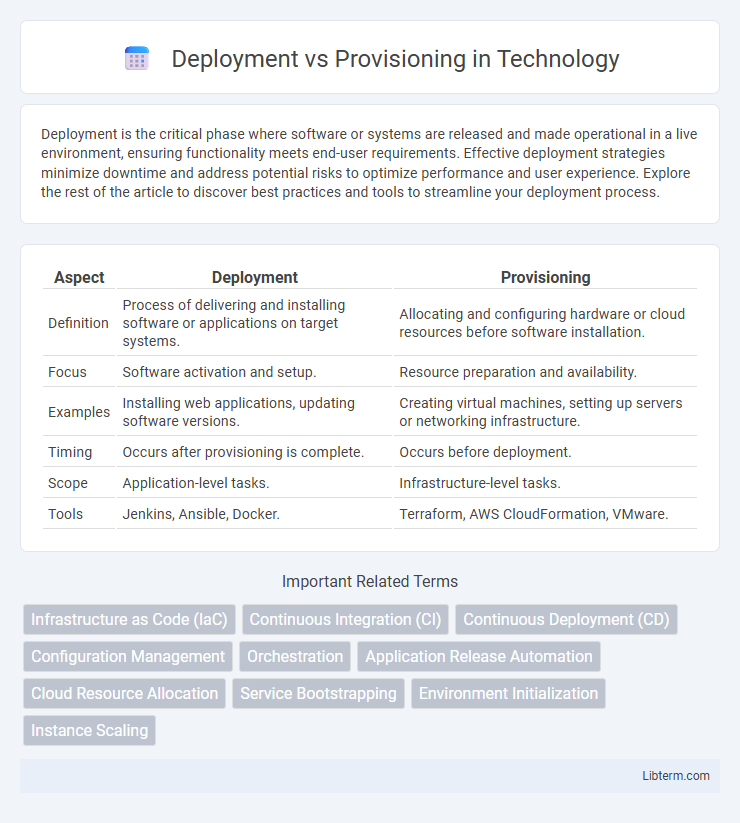Deployment is the critical phase where software or systems are released and made operational in a live environment, ensuring functionality meets end-user requirements. Effective deployment strategies minimize downtime and address potential risks to optimize performance and user experience. Explore the rest of the article to discover best practices and tools to streamline your deployment process.
Table of Comparison
| Aspect | Deployment | Provisioning |
|---|---|---|
| Definition | Process of delivering and installing software or applications on target systems. | Allocating and configuring hardware or cloud resources before software installation. |
| Focus | Software activation and setup. | Resource preparation and availability. |
| Examples | Installing web applications, updating software versions. | Creating virtual machines, setting up servers or networking infrastructure. |
| Timing | Occurs after provisioning is complete. | Occurs before deployment. |
| Scope | Application-level tasks. | Infrastructure-level tasks. |
| Tools | Jenkins, Ansible, Docker. | Terraform, AWS CloudFormation, VMware. |
Introduction to Deployment and Provisioning
Deployment involves the process of installing, configuring, and enabling software applications or systems for use in a specific environment, ensuring operational readiness and integration. Provisioning refers to the allocation and setup of necessary resources such as servers, storage, network configurations, and user access to support the deployment of applications or services. Both deployment and provisioning are critical stages in IT infrastructure management, enabling seamless software delivery and efficient resource utilization.
Defining Deployment
Deployment refers to the process of installing, configuring, and enabling a software application or system onto a target environment, ensuring it is fully operational for end-users. It encompasses activities such as code release, environment setup, and activation of services, often automated through continuous integration and continuous deployment (CI/CD) pipelines. Deployment aims to transition applications from development or testing stages to production, ensuring stability, functionality, and accessibility.
Defining Provisioning
Provisioning refers to the process of setting up and configuring IT resources such as servers, networks, and storage to prepare them for use. It involves allocating hardware, installing software, and configuring settings to ensure the infrastructure meets operational requirements. This foundational step precedes deployment, enabling seamless application installation and performance within a ready environment.
Key Differences Between Deployment and Provisioning
Deployment involves the process of installing, configuring, and enabling software or applications on a target environment, ensuring operational readiness. Provisioning refers to the allocation and setup of necessary resources such as servers, storage, and network components before deployment can occur. Key differences include deployment focusing on software readiness and activation, while provisioning emphasizes preparing the underlying infrastructure to support that software.
The Role of Provisioning in DevOps
Provisioning plays a critical role in DevOps by automating the setup of infrastructure, including servers, networks, and storage, to create consistent environments for development, testing, and production. It ensures rapid, repeatable, and scalable environment creation through Infrastructure as Code (IaC) tools like Terraform, Ansible, and Puppet. Effective provisioning reduces manual errors and accelerates continuous integration and continuous delivery (CI/CD) pipelines by providing standardized, pre-configured resources.
Deployment Processes and Best Practices
Deployment processes involve systematically transferring software applications from development to production environments, ensuring functionality, security, and performance. Best practices for deployment emphasize automated workflows, continuous integration and delivery (CI/CD) pipelines, version control, and thorough testing to minimize downtime and errors. Effective monitoring and rollback strategies further enhance reliability and facilitate quick recovery from deployment failures.
Common Tools for Deployment and Provisioning
Common tools for deployment include Jenkins, GitLab CI/CD, and Ansible Tower, which automate the release of applications to production environments. Provisioning typically utilizes tools like Terraform, AWS CloudFormation, and Chef for automating the setup and configuration of infrastructure resources. Both deployment and provisioning tools streamline workflows, reduce manual errors, and enhance scalability in IT operations.
Challenges in Deployment vs Provisioning
Deployment faces challenges such as environment inconsistencies, complex configuration settings, and downtime risks during updates, which can impact system availability and user experience. Provisioning challenges include managing resource allocation, automating setup processes, and ensuring scalability to meet dynamic demand without over-provisioning or resource wastage. Both deployment and provisioning require robust automation tools and monitoring to minimize errors, optimize performance, and maintain operational efficiency.
Use Cases: Deployment vs Provisioning
Deployment involves the process of installing, configuring, and enabling software applications onto specific servers or devices, commonly used in application updates, software rollouts, and environment setups. Provisioning focuses on preparing and allocating the necessary resources such as hardware, storage, network access, and user accounts, crucial in cloud infrastructure setup, virtual machine creation, and user onboarding. Use cases for deployment include continuous integration/continuous delivery (CI/CD) pipelines and container orchestration, while provisioning is integral to automated resource management and scalable infrastructure as code (IaC) practices.
Conclusion: Choosing the Right Approach
Choosing between deployment and provisioning depends on the specific IT environment and operational goals, as provisioning sets up necessary infrastructure while deployment focuses on releasing applications or services onto that infrastructure. Efficient IT management requires integrating both processes to ensure seamless service delivery and optimal resource utilization. Organizations prioritizing scalability and automation benefit from provisioning strategies, whereas rapid software updates emphasize streamlined deployment workflows.
Deployment Infographic

 libterm.com
libterm.com